As a sports photographers at the Olympics in Sochi
 Bashny.Net
Bashny.Net
Professional photographers are not small, but among them is not so much those who know how to do sports photography. Occupation sports photographer - work is not easy, it is always necessary to choose the correct angle and shoot athletes often have to move. In this post I want to show you how to operate sports photographers at the Olympic Games in Sochi. Priority television is available in all: the best site for the filming, the first right to interview athletes, extended accreditation, etc. Photographers, written press and radio are a little on the sidelines, but especially slighted no one feels himself, as for all these categories are very comfortable working conditions.
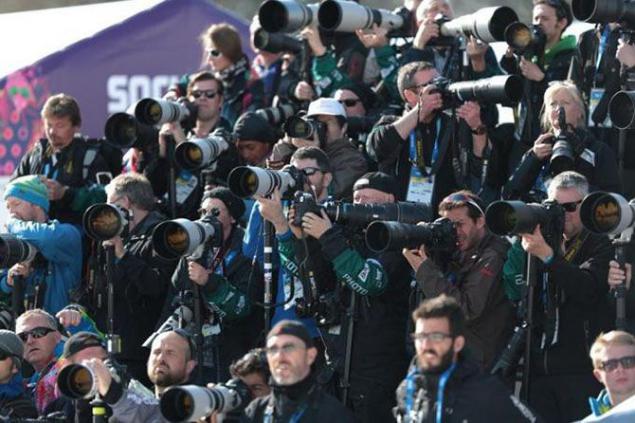
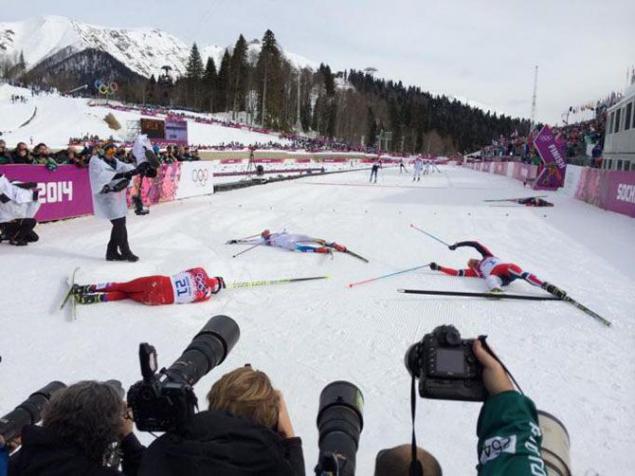
Classic sports photographer looks that way.
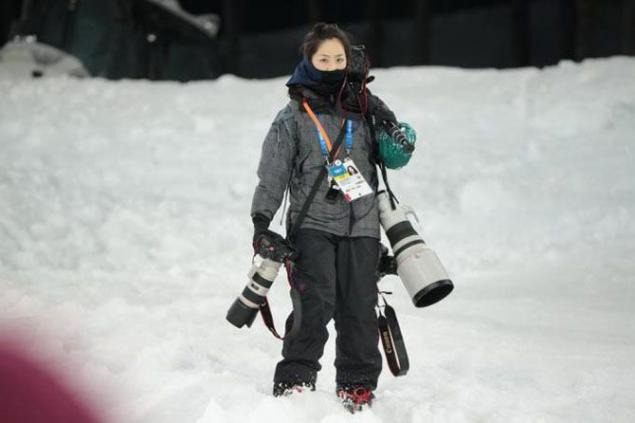
A couple more.
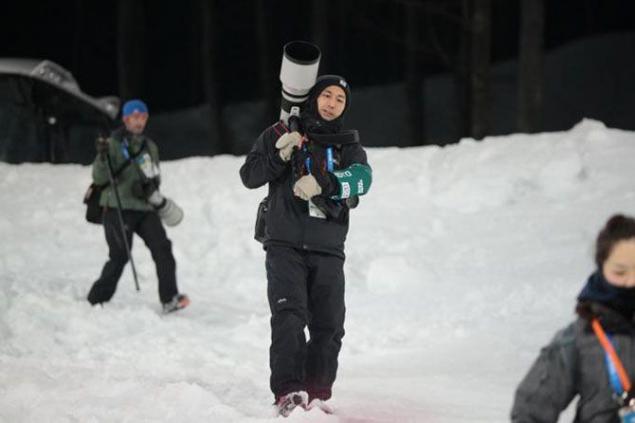
I do not know why it turned out that all three of them - the Japanese. The Europeans also do not spare the stomach and drag on itself to 20 kg of equipment.
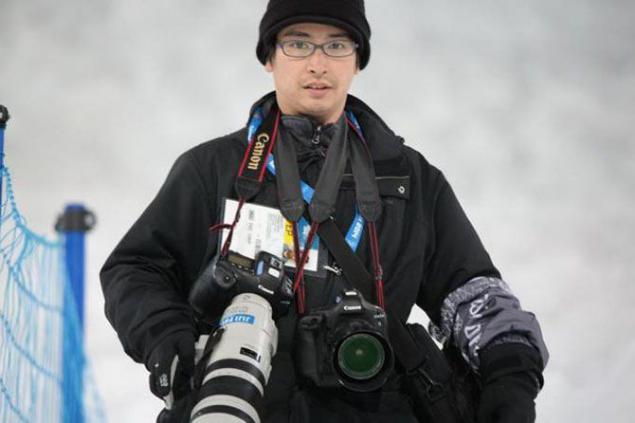
Photographers of the new formation, they "instagramschiki" look different ...
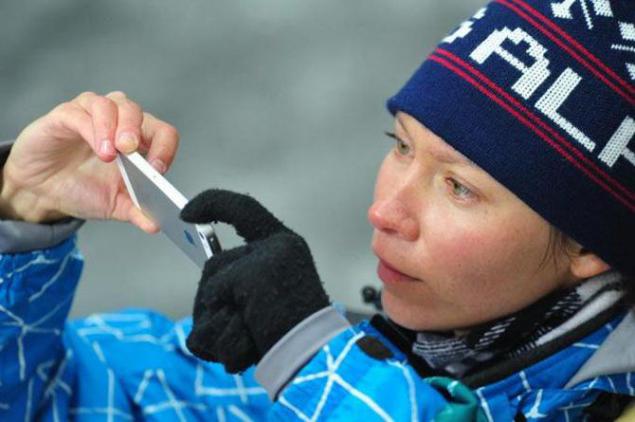
However, this did not prevent pro forma throw the one-two cameras and body kits from all sides big white lenses. Give something for free, a sin not to try something new.

Photographers - savvy guys. In many sports, you need to take a favorable advance fotopozitsii. For example, to the background with the Olympic rings beautifully complemented frame or finishing position of "head", or exit from a bend skater to receive a perfect diagonal. Yes, many things. Therefore, it is necessary to come to a couple of hours before the event and to book their place of Photography (here, as elsewhere, the size of the lens is set).
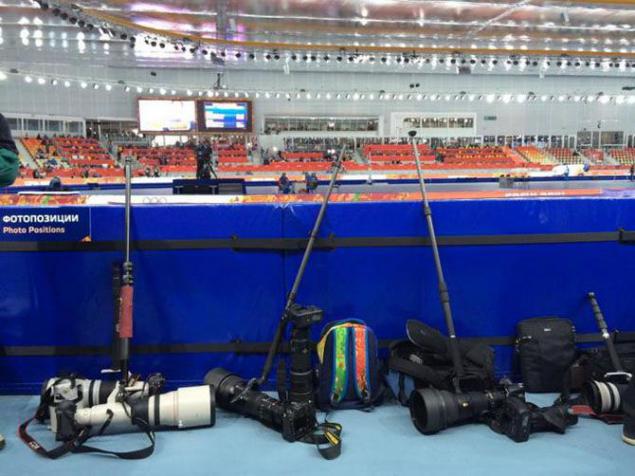
Most Advanced wanted to spit on a crush near the low point shooting and, in addition to 30 kg of equipment, being dragged into the mountains ladder.
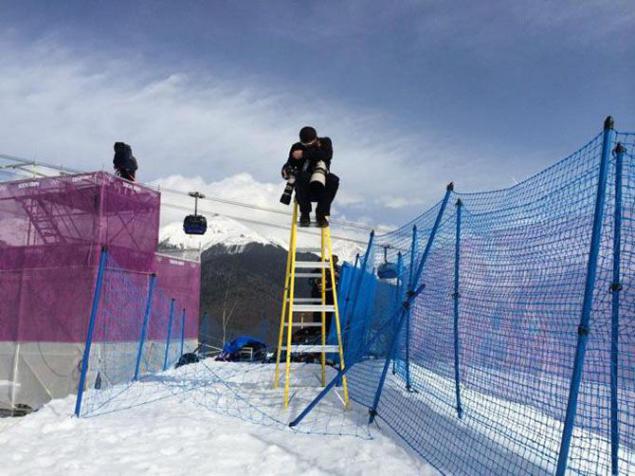
All of the press center, main and auxiliary, has a special room for photographers - a fairly large room, equipped with tables, outlets, lockers for storage of equipment and mandatory information desk where fotomenedzhery object give all the necessary information about fotopozitsiyah on site. For example, here's what a circuit fotopozitsy on the piste.
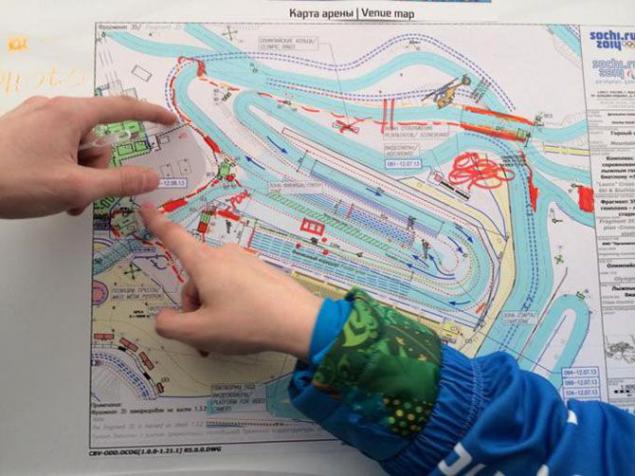
And this is - Ice Palace Grand.
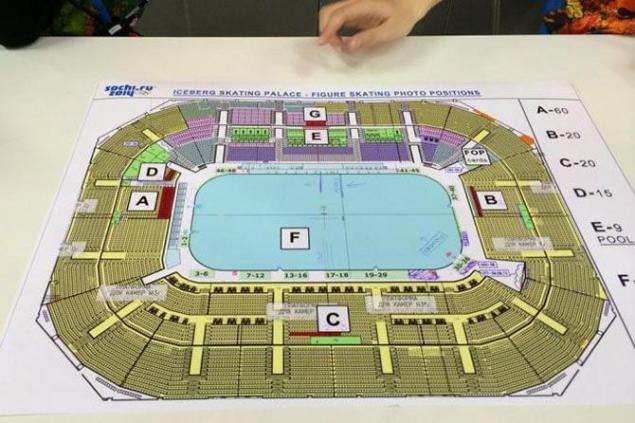
Bobsleigh track was the most confusing. Fotopozitsii usually indicated in red.
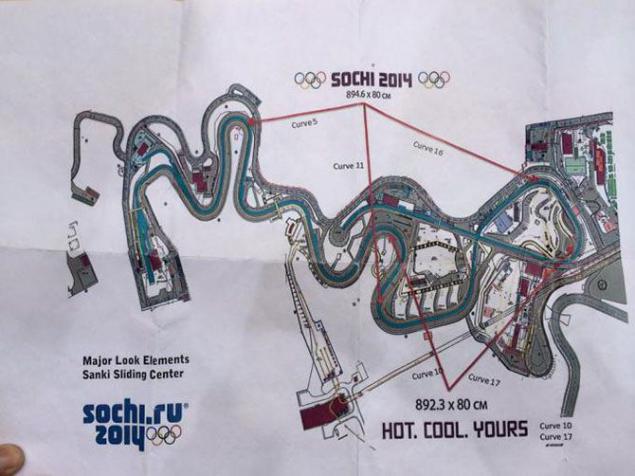
Room photographers in the Main Media Center ...

... And mining.
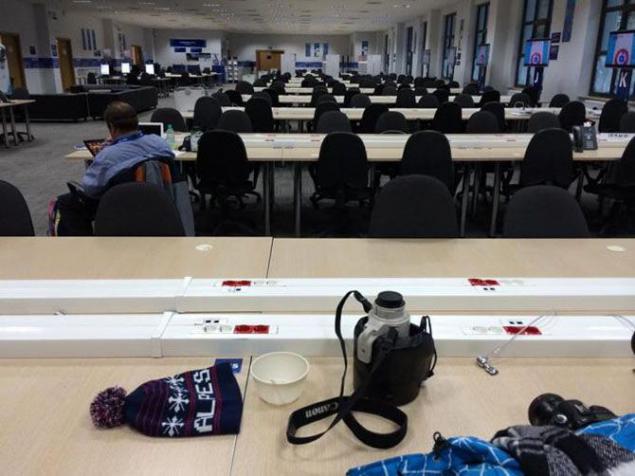
Staff photo rooms are very friendly and helpful. From the first day the Olympics started to decorate the walls of the room the best pictures of the day.
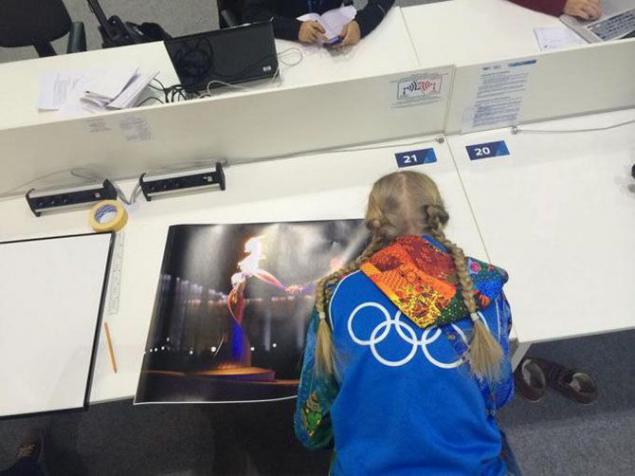
The most austere room of photographers is on freestyle stadium HAM. There are only standing room.
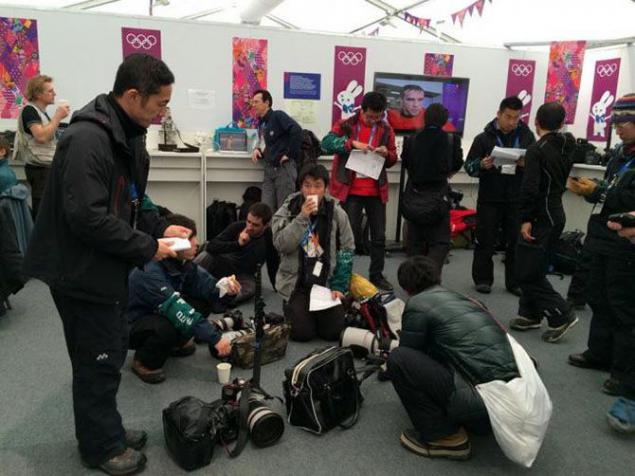
Each photograph is given a special license sleeve, without which tolerance is impossible object. Lose sleeve can afford only those members who account for at least fifteen Olympic Games and in the Olympic fototusovke knows any dog. Sleeves as accreditation, during the Olympic Games have become an integral part of the human body. Accreditations, not to forget them in the morning, usually hung on top of jackets.
At the Olympics accredited about eight photographers, and most of them have green sleeves (so-called «PHOTO»). This means that a photographer with the sleeve to work on objects in the main crowd, without any priority.
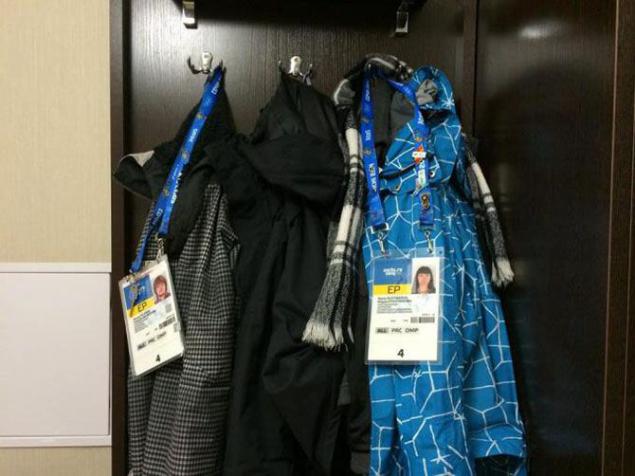
In point shooting and sometimes you have to work to knock elbows, but most photographers - quite adequate people.

Fotopozitsiya finish bobsled.
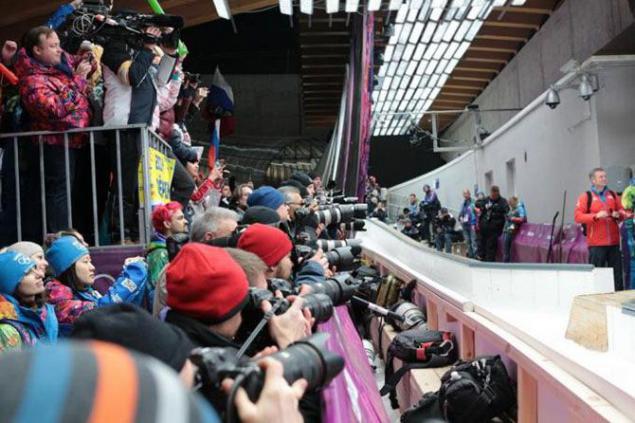
Vantage point on the piste.
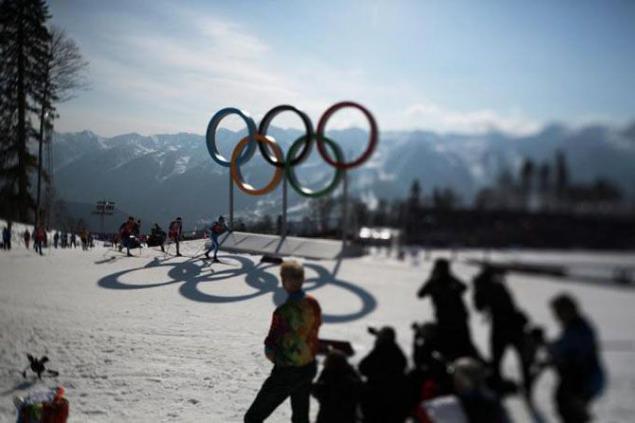
Fotopozitsii skating on a bend range.

In the mountains, the photographers are allowed to walk the entire length of the track, except in places intended for trainers, so the choice of points with beautiful views of endless. You can, for example, lie low, as a partisan, biathlon shooting range and shoot precarious position.

Grey Sleeve (PHOTO POOL) members receive a so-called "pool" - usually a reporter world agencies such as, AP, AFP, Reuters and our RIA-Novosti that Sochi is a national host agency. Pool floaters members receive the most favorable fotopozitsii. For example, a small patch of the biathlon shooting range in front, where four people can fit all. At the finish of ski racing - this is the first series on a special pedestal for photographers.
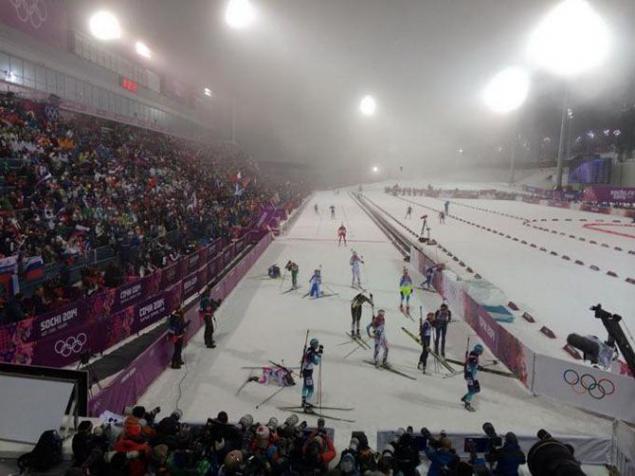
On the hockey - a few central points on the upper fotopozitsiyah. Typically, pool floaters place affix stickers to the agency, which represents the photographer. If the place is empty, it can be easy to operate and simple guys.
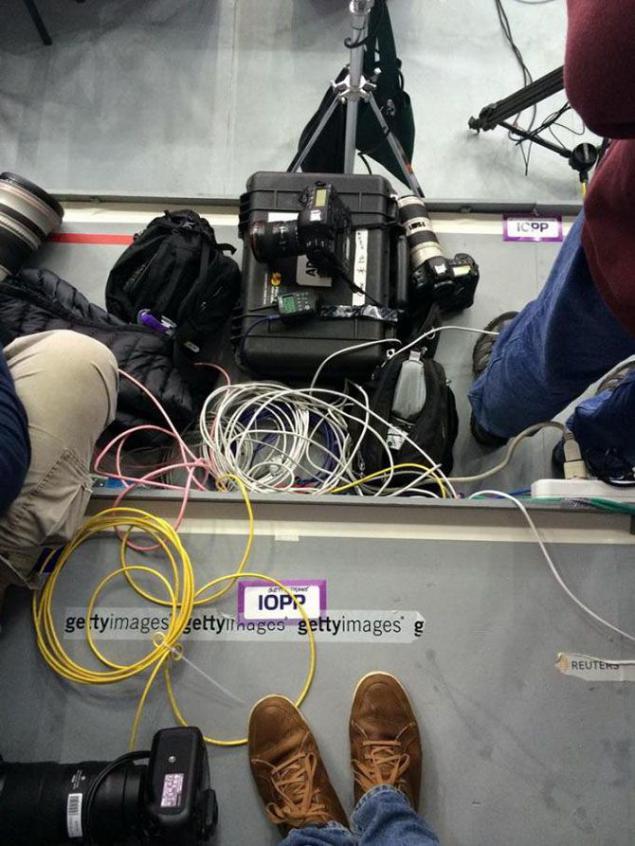
The elite of world sports photography works for the IOC and for these photographers are assigned the most "delicious" point shooting.

Typically, the work of the agency is photographer in the daily hilling one or two sports throughout the Olympics. At the facility has a team of 2-3 people, thus covering most of the area of competition. On the track, usually one photographer standing on the start-finish line, the second - in the most dangerous corners, the third - in a more or less free mode. On the hockey - one at the side, the other on top of the third from the top, too, on the opposite platform. Fourth on the opposite side, if the match is very important.

Jobs newspaper or magazine photos more dynamic, because constantly having to wander from the coastal cluster in the mountain, and vice versa. On the one hand, it's exhausting, but it pays a variety of subjects tired head.


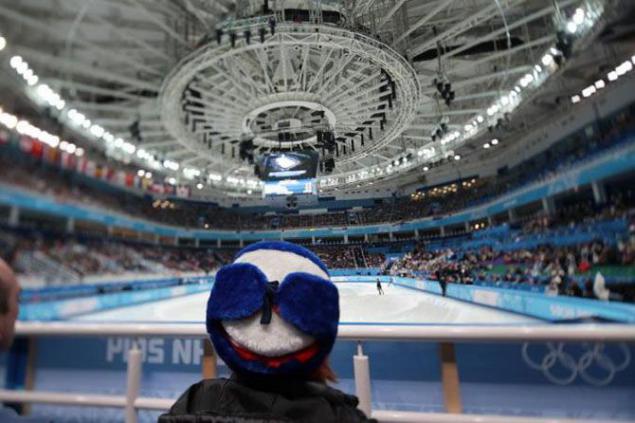
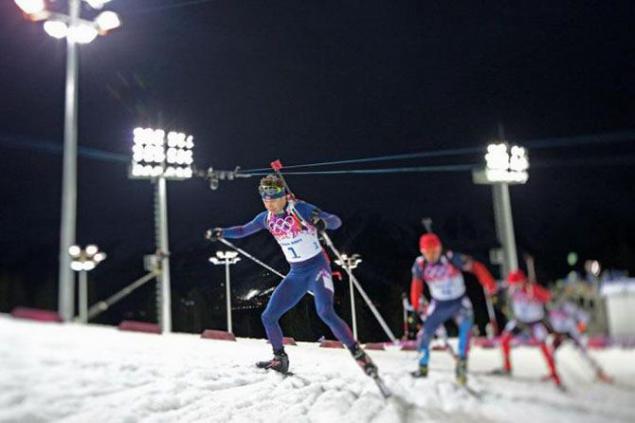
To access fotopozitsiyam on hockey in the first place must attend an additional ticket for passage to the arena (the most nimble issued by prior arrangement). Next you need to do a complicated procedure for the exchange of their sleeves to blue, if you want to shoot with the top points, or take a special numbered on the bench at the side. Because of the huge interest in hockey all places is not enough, so everything is very strict.

Flower ceremony - as a special genre for photographers.

At the ceremony allowed only pool floaters photographers and several photographers from every country, from which the athlete was on the podium. Otherwise, avoid the crowds and the hustle impossible.
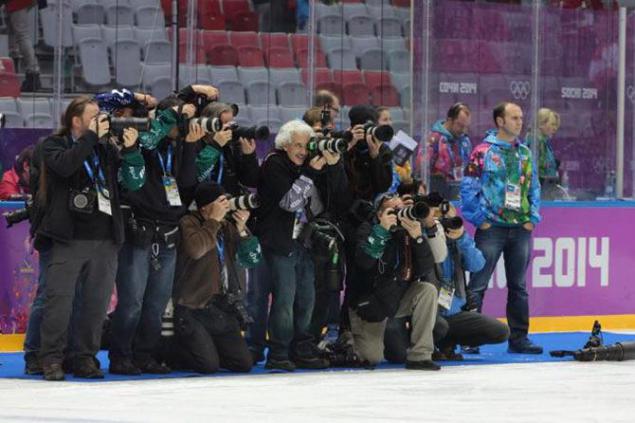
International agencies feel affection for remoutam - radio-controlled cameras - and set them on the points that are available for photographers during the competition. In hockey, this is the point of the door, on the ski jumping - a springboard.
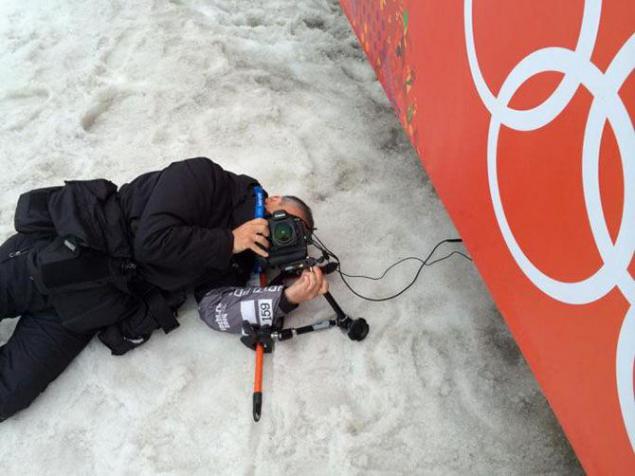
On the bobsled - the highest point of the finish.

On remouty over hokkenymi gate usually put wide-angle lenses or zoom 70-200. There are unique robots that can manage heavy long lenses. The photographer is just the right time to remember to press the shutter button on the radio control. Pictures with these points are obtained simply Freaky.
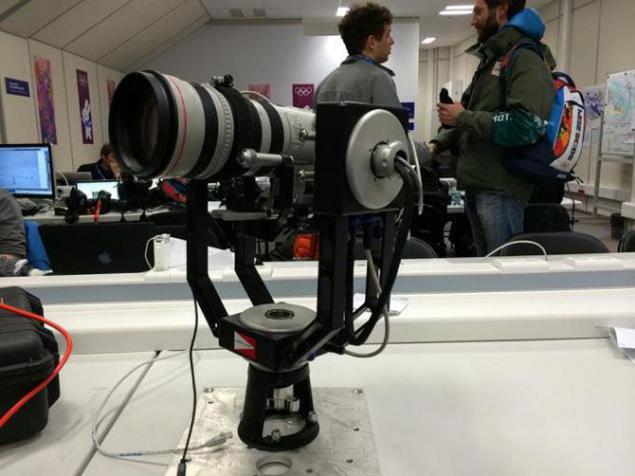
Let's talk about the hardware in more detail. In Pribrezhnoi Mining and media centers are points of repair and free rental equipment Canon and Nikon (in the photo - Canon service in the mountain media center).

Here you can take a day or any camera lens from the professional line manufacturers. Usually, photographers do not bother and take long-focus lenses.
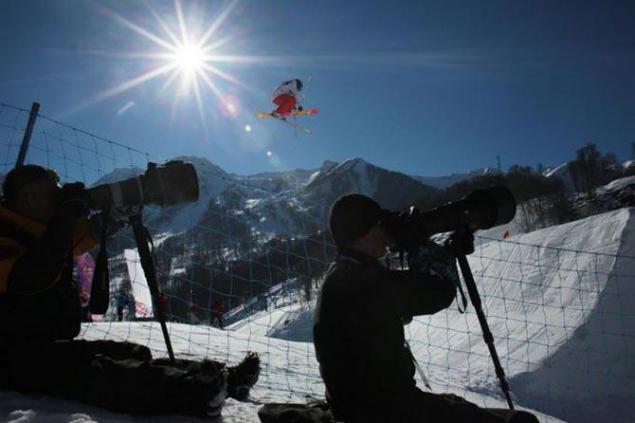
Although the Canon lineup can take great tilt-shift (professional lenses for shooting architecture) with different focal lengths and add to the sports photography creative composing. I literally fell in love with these lenses and tried all focal lengths: 17mm, 24mm and 90mm (21-25). The photo - a tilt-shift lens is 17 mm.
At the Sochi Olympics is the way a long lens from Canon 200-400 F4 L IS USM Extender 1.4. In principle, it is absolutely for all sports with his missing head. Built-in converter allows you to shoot high quality items such as bobsleigh finish, tricks in the halfpipe, the start of cross-country skiing and biathlon, and a bunch of a bunch of stuff. The quality of the lens in an exciting, perfect sharpness. No wonder that when at 9 am to get a lens in the rental is still possible, the photographer 9.05 are guaranteed to remain with the nose.
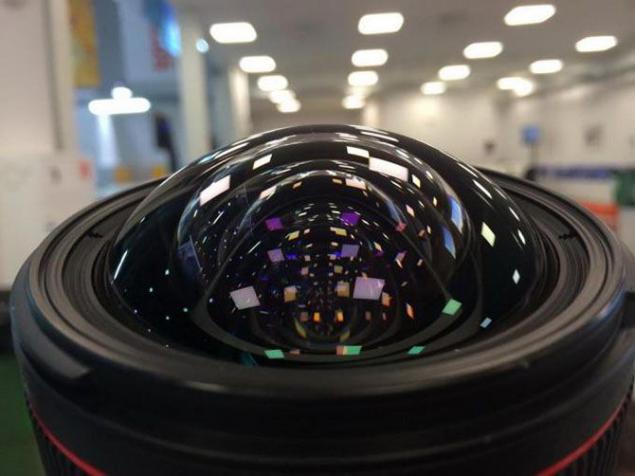
In the photo the subject in the foreground to the left and half of the photographers.
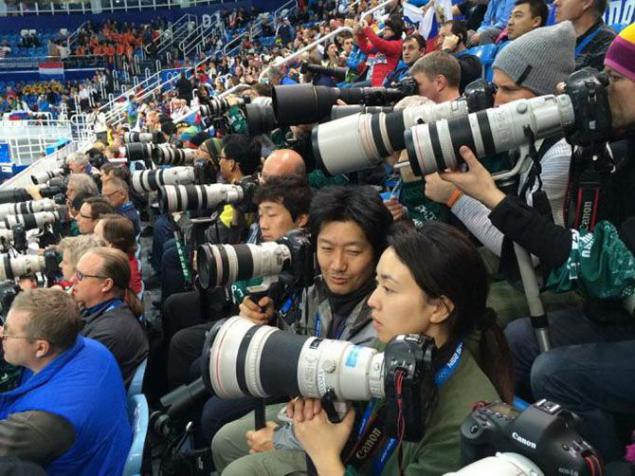
This image shot on the focal length of 533mm, ie in the course I went to built-in converter. Such an object is worth 11 thousand. Dollars, and most editors can only dream about the inclusion of the zoom into the ranks of the editorial techniques.
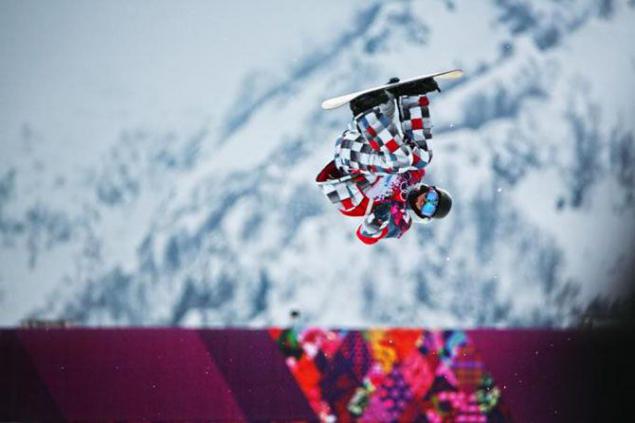
Some photographers do not recognize zooms and removed only fixes. At telephoto fixes the image quality just space, and the photo is definitely worth the physical effort, but to drag the carcass weighing several kilograms, for example, only "Krupnyakov" on the biathlon shooting range, the strength is not for everyone. For clarity in the photo - Case for Nikon lens 800mm 5.6 on the scale of the room.

The most difficult working conditions for the photographer - wet snow or rain. In this case, save the special capes, fully protect the camera and lens.
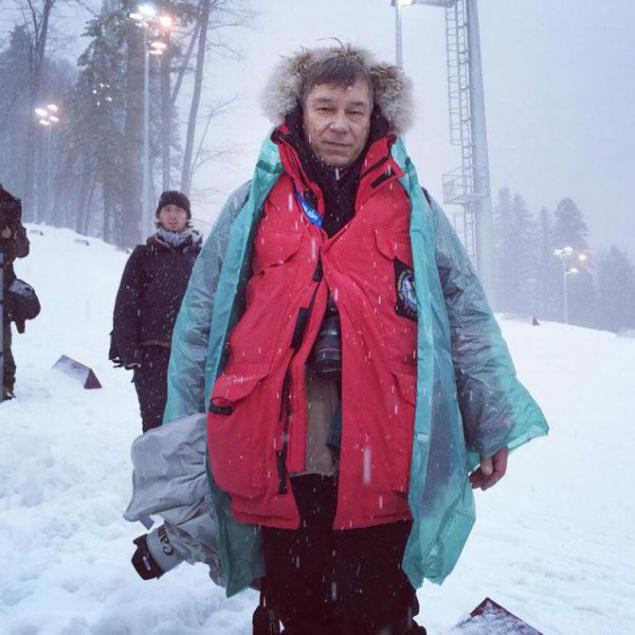
Wraps are issued at service centers when the weather begins to deteriorate. The body of the photographer, of course, is not as important as technology, and in any case within a few hours of shooting all the clothes get wet, disposable raincoats but has not been canceled.
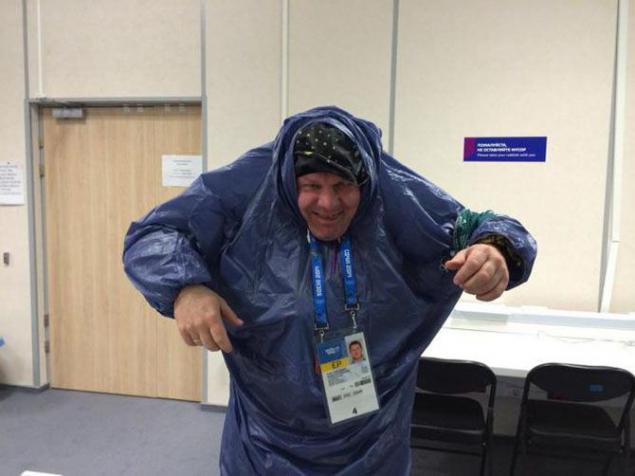
After shooting in cold and wet weather cameras for some time transformed into living beings. At such times it is better not to touch, and left alone as long as they are not heat otpoteyut and again will not be ready for operation.

At some sites the Mountain Cluster, such as ski acrobatics, half-pipe, ski discipline et al., Enter the track without climbing "cats" is prohibited.

Despite the fact that the Olympic Games have to work constantly in the crowd, the photos are not alien to the sense of personality, which some have expressed the most direct way - airbrushing on telephoto lens. And it looks great, and push less!
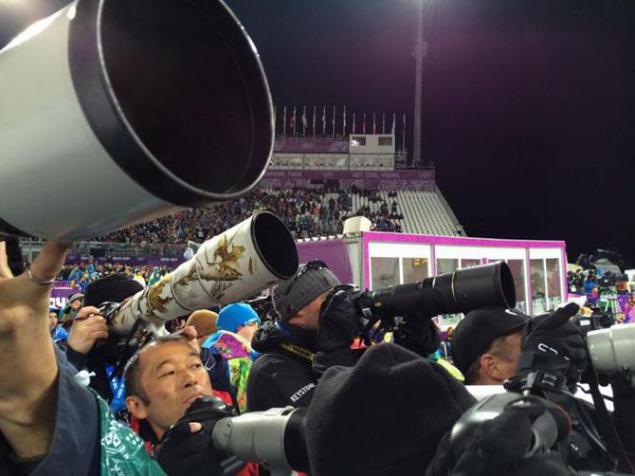
Most photographers transfers pictures directly from the scene because in modern times the speed of appearance of the photo on the newswire perhaps the main subject of competition agencies. These races are completely crushed the image quality, because news reporters do not have time to choose the best treatment and the frame instantly sends something more or less acceptable. Also, much depends on the managing editor. If a computer monitor in the wording of a man sitting, indifferent to the image, it may miss the brilliant picture photographer who give 100 "on the front line».

Already in the press center can be thoughtfully otsmotret and dismantle the entire shoot.
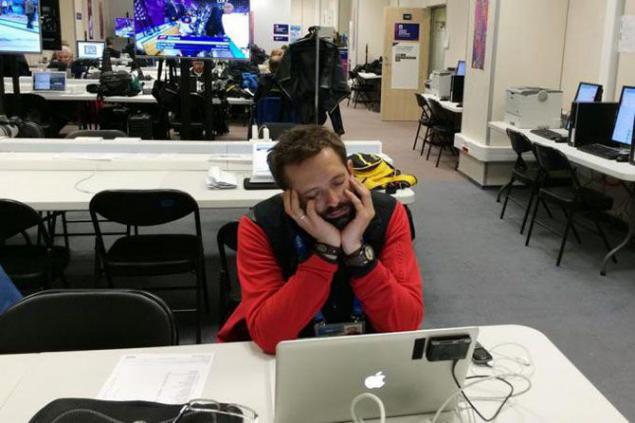
After working in the press center of the photo with a sense of accomplishment goes home to recharge your batteries: technology in the first place, a dream given to the strength of five o'clock.
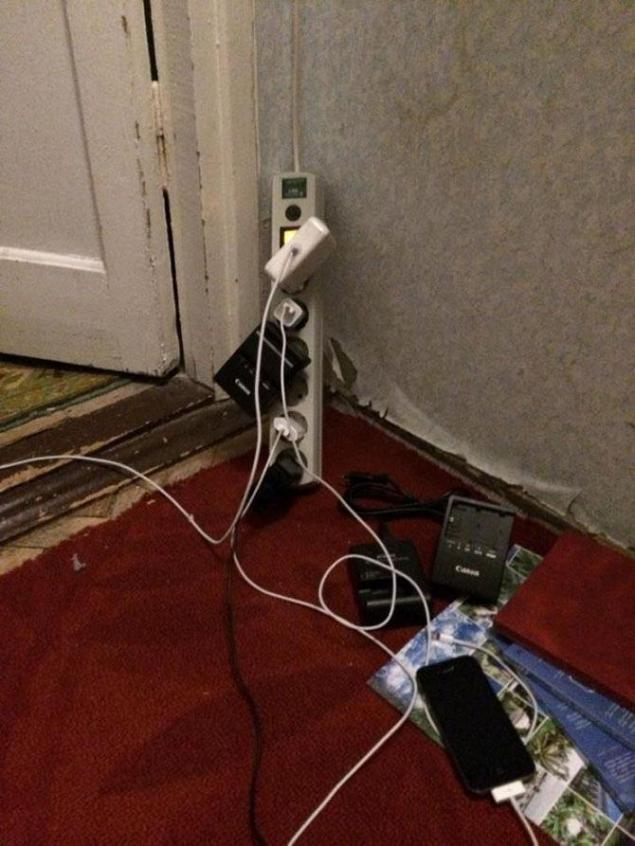
And the dream of a brighter future for photographers, when British scientists have come up with cell phone camera of the highest quality, with a universal zoom and a speed of 14 frames per second. And then do not have to drag yourself to 30 kg piece of iron, and you can focus on choosing fashionable cheholchika for your phone.
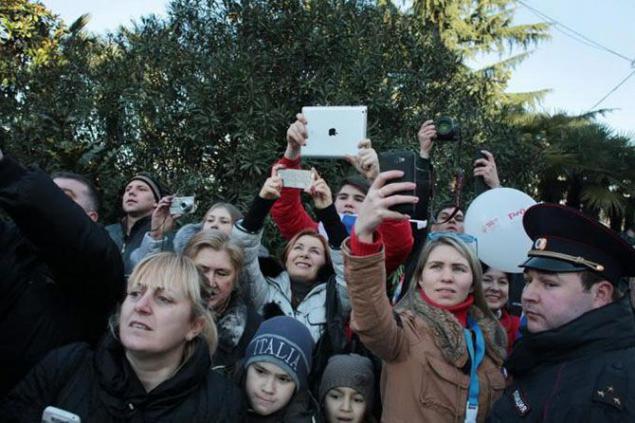
Source: bigpicture.ru


Classic sports photographer looks that way.

A couple more.

I do not know why it turned out that all three of them - the Japanese. The Europeans also do not spare the stomach and drag on itself to 20 kg of equipment.

Photographers of the new formation, they "instagramschiki" look different ...

However, this did not prevent pro forma throw the one-two cameras and body kits from all sides big white lenses. Give something for free, a sin not to try something new.

Photographers - savvy guys. In many sports, you need to take a favorable advance fotopozitsii. For example, to the background with the Olympic rings beautifully complemented frame or finishing position of "head", or exit from a bend skater to receive a perfect diagonal. Yes, many things. Therefore, it is necessary to come to a couple of hours before the event and to book their place of Photography (here, as elsewhere, the size of the lens is set).

Most Advanced wanted to spit on a crush near the low point shooting and, in addition to 30 kg of equipment, being dragged into the mountains ladder.

All of the press center, main and auxiliary, has a special room for photographers - a fairly large room, equipped with tables, outlets, lockers for storage of equipment and mandatory information desk where fotomenedzhery object give all the necessary information about fotopozitsiyah on site. For example, here's what a circuit fotopozitsy on the piste.

And this is - Ice Palace Grand.

Bobsleigh track was the most confusing. Fotopozitsii usually indicated in red.

Room photographers in the Main Media Center ...

... And mining.

Staff photo rooms are very friendly and helpful. From the first day the Olympics started to decorate the walls of the room the best pictures of the day.

The most austere room of photographers is on freestyle stadium HAM. There are only standing room.

Each photograph is given a special license sleeve, without which tolerance is impossible object. Lose sleeve can afford only those members who account for at least fifteen Olympic Games and in the Olympic fototusovke knows any dog. Sleeves as accreditation, during the Olympic Games have become an integral part of the human body. Accreditations, not to forget them in the morning, usually hung on top of jackets.
At the Olympics accredited about eight photographers, and most of them have green sleeves (so-called «PHOTO»). This means that a photographer with the sleeve to work on objects in the main crowd, without any priority.

In point shooting and sometimes you have to work to knock elbows, but most photographers - quite adequate people.

Fotopozitsiya finish bobsled.

Vantage point on the piste.

Fotopozitsii skating on a bend range.

In the mountains, the photographers are allowed to walk the entire length of the track, except in places intended for trainers, so the choice of points with beautiful views of endless. You can, for example, lie low, as a partisan, biathlon shooting range and shoot precarious position.

Grey Sleeve (PHOTO POOL) members receive a so-called "pool" - usually a reporter world agencies such as, AP, AFP, Reuters and our RIA-Novosti that Sochi is a national host agency. Pool floaters members receive the most favorable fotopozitsii. For example, a small patch of the biathlon shooting range in front, where four people can fit all. At the finish of ski racing - this is the first series on a special pedestal for photographers.

On the hockey - a few central points on the upper fotopozitsiyah. Typically, pool floaters place affix stickers to the agency, which represents the photographer. If the place is empty, it can be easy to operate and simple guys.

The elite of world sports photography works for the IOC and for these photographers are assigned the most "delicious" point shooting.

Typically, the work of the agency is photographer in the daily hilling one or two sports throughout the Olympics. At the facility has a team of 2-3 people, thus covering most of the area of competition. On the track, usually one photographer standing on the start-finish line, the second - in the most dangerous corners, the third - in a more or less free mode. On the hockey - one at the side, the other on top of the third from the top, too, on the opposite platform. Fourth on the opposite side, if the match is very important.

Jobs newspaper or magazine photos more dynamic, because constantly having to wander from the coastal cluster in the mountain, and vice versa. On the one hand, it's exhausting, but it pays a variety of subjects tired head.




To access fotopozitsiyam on hockey in the first place must attend an additional ticket for passage to the arena (the most nimble issued by prior arrangement). Next you need to do a complicated procedure for the exchange of their sleeves to blue, if you want to shoot with the top points, or take a special numbered on the bench at the side. Because of the huge interest in hockey all places is not enough, so everything is very strict.

Flower ceremony - as a special genre for photographers.

At the ceremony allowed only pool floaters photographers and several photographers from every country, from which the athlete was on the podium. Otherwise, avoid the crowds and the hustle impossible.

International agencies feel affection for remoutam - radio-controlled cameras - and set them on the points that are available for photographers during the competition. In hockey, this is the point of the door, on the ski jumping - a springboard.

On the bobsled - the highest point of the finish.

On remouty over hokkenymi gate usually put wide-angle lenses or zoom 70-200. There are unique robots that can manage heavy long lenses. The photographer is just the right time to remember to press the shutter button on the radio control. Pictures with these points are obtained simply Freaky.

Let's talk about the hardware in more detail. In Pribrezhnoi Mining and media centers are points of repair and free rental equipment Canon and Nikon (in the photo - Canon service in the mountain media center).

Here you can take a day or any camera lens from the professional line manufacturers. Usually, photographers do not bother and take long-focus lenses.

Although the Canon lineup can take great tilt-shift (professional lenses for shooting architecture) with different focal lengths and add to the sports photography creative composing. I literally fell in love with these lenses and tried all focal lengths: 17mm, 24mm and 90mm (21-25). The photo - a tilt-shift lens is 17 mm.
At the Sochi Olympics is the way a long lens from Canon 200-400 F4 L IS USM Extender 1.4. In principle, it is absolutely for all sports with his missing head. Built-in converter allows you to shoot high quality items such as bobsleigh finish, tricks in the halfpipe, the start of cross-country skiing and biathlon, and a bunch of a bunch of stuff. The quality of the lens in an exciting, perfect sharpness. No wonder that when at 9 am to get a lens in the rental is still possible, the photographer 9.05 are guaranteed to remain with the nose.

In the photo the subject in the foreground to the left and half of the photographers.

This image shot on the focal length of 533mm, ie in the course I went to built-in converter. Such an object is worth 11 thousand. Dollars, and most editors can only dream about the inclusion of the zoom into the ranks of the editorial techniques.

Some photographers do not recognize zooms and removed only fixes. At telephoto fixes the image quality just space, and the photo is definitely worth the physical effort, but to drag the carcass weighing several kilograms, for example, only "Krupnyakov" on the biathlon shooting range, the strength is not for everyone. For clarity in the photo - Case for Nikon lens 800mm 5.6 on the scale of the room.

The most difficult working conditions for the photographer - wet snow or rain. In this case, save the special capes, fully protect the camera and lens.

Wraps are issued at service centers when the weather begins to deteriorate. The body of the photographer, of course, is not as important as technology, and in any case within a few hours of shooting all the clothes get wet, disposable raincoats but has not been canceled.

After shooting in cold and wet weather cameras for some time transformed into living beings. At such times it is better not to touch, and left alone as long as they are not heat otpoteyut and again will not be ready for operation.

At some sites the Mountain Cluster, such as ski acrobatics, half-pipe, ski discipline et al., Enter the track without climbing "cats" is prohibited.

Despite the fact that the Olympic Games have to work constantly in the crowd, the photos are not alien to the sense of personality, which some have expressed the most direct way - airbrushing on telephoto lens. And it looks great, and push less!

Most photographers transfers pictures directly from the scene because in modern times the speed of appearance of the photo on the newswire perhaps the main subject of competition agencies. These races are completely crushed the image quality, because news reporters do not have time to choose the best treatment and the frame instantly sends something more or less acceptable. Also, much depends on the managing editor. If a computer monitor in the wording of a man sitting, indifferent to the image, it may miss the brilliant picture photographer who give 100 "on the front line».

Already in the press center can be thoughtfully otsmotret and dismantle the entire shoot.

After working in the press center of the photo with a sense of accomplishment goes home to recharge your batteries: technology in the first place, a dream given to the strength of five o'clock.

And the dream of a brighter future for photographers, when British scientists have come up with cell phone camera of the highest quality, with a universal zoom and a speed of 14 frames per second. And then do not have to drag yourself to 30 kg piece of iron, and you can focus on choosing fashionable cheholchika for your phone.

Source: bigpicture.ru
Tags
See also
Again about the space
Water from air: How atmospheric water generators
Naomi wolf: Women are used to perceive themselves as a cheap imitation of a model's photo
How to work with e-mail Tim cook, bill gates and other top managers
Sporting moments from an unusual angle (22 photos)
As a Chinese store online store (9 photos)
How does the American police
How does the service "02" (19 photos)
Which of these are real photos (43 photos)
How did the Tesla tower power transmission - own investigation

















